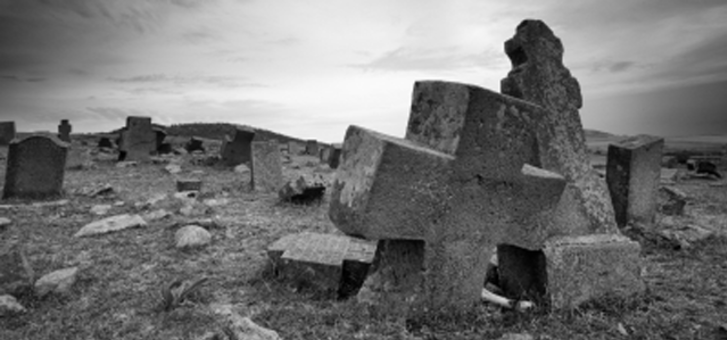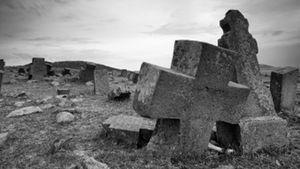I stood in the partial shade of a large, leafy gum tree that canopied the yard of a small dwelling in a remote Aboriginal community.
I was the only white fella and one of two pastors present. There, the relatives of the deceased, who had just laid their husband, father, grandfather, brother, uncle and cousin to rest in the local cemetery, gathered to continue mourning.
The widow sat with her closest kin on mattresses and blankets that littered the red sandy soil. More than 80 people sat or stood, surrounding the most grieved in an almost eerie silence. Low mumbles and a few tears flowed as the mourners put their heads together, with one arm around the other and the other hand covering the eyes.
Then it happened. A short, middleaged woman stood up and walked from the edge of the people to the middle of the group. With eyes flashing, finger pointing and mouth yelling at the top of her voice, she fumed at the closest relatives sitting with the widow. In a flash, another taller, older woman came from another flank and beelined straight toward the first woman, waving her arms and yelling back. This triggered a cacophony of noise and motion.
This was a real fight. The adult children and husband of the first woman then stood and yelled at others. In turn, they stood and retaliated with verbal abuse. At times, there were 10 or more people yelling at each other. How anyone knew what was being said or who was being blamed, I will never know.
It was a flurry of English and local language, swearing and cursing, anger and accusation.
In the ensuing hour, men and woman took off their tops or shoes, ready to fight. Fists were clenched and swung wildly. Plastic water bottles and steel cups landed on people’s heads as the fight ebbed and flowed. Calm, casual and unenergetic people showed their flair and emotion! At times, things quieted and one person was able to defend the charges.
But then it would be on again for one and all—bedlam. Then another would speak alone and be heard for awhile.
Respect was shown for these community leaders—but not for long. After giving a powerfully-charged speech, the person would fade back into the background and allow someone else to make a point from their perspective. It was like tag-team wrestling.
What amused me, however, was the use of the green water flask placed right beside the widow. Whenever anyone was thirsty—no matter which side they were on—they would walk over to the flask and take a large gulp of the water, undeterred. Obviously, the right to water was not the issue! I had heard of what was taking place but in my four years associating with these people and attending many funerals, had never witnessed it first hand.
Eventually, one young woman seemed to be singled out. She was getting most of the punches and water bottle strikes.
As the battle raged, it seemed the more-distant relatives were standing on the outer like me, assessing the situation.
During the whole time, people were coming and going, carrying babies and children, oblivious to the mayhem around them. Cigarettes and food were also shared. At one point, a couple of the senior people—a man and a woman— slipped away and came back with mulla mulla sticks. These sticks were almost 1.5 metres long and about 10 centimetres thick, well polished from sweaty handling.
At first, the sticks were a symbol of authority. People glanced knowingly to those who held them behind their backs. Eventually, the short stubby man with the mulla mulla, who had hardly said a thing, casually strolled over to the young woman taking most of the physical and verbal abuse. He whacked her over the middle of her upper back and she stumbled forward without a whimper. More anger and angst erupted but no-one attacked the accuser with the stick, who had made the most telling blow.
For the uninitiated, this would not make much sense. Why the yelling accusations? Why the wild behaviour from generally passive people? Why this enormous amount of anger being released publically?
But in this traditional Aboriginal culture, someone has to take the blame for each death. All humans rebel at the consequences of death. No-one likes the seemingly-eternal separation death brings—this is why we want to blame.
The fight was determining which group and person in the kin group was to take the blame. Later, dialogue with some of those involved revealed that the person who took the blame was a close relative who put the deceased in the ambulance—from which he never returned. However, other community issues surfaced in the hostile environment.
For a fleeting moment, I thought I should step into the middle of the fight. I was a white man—we had introduced alcohol that sends many Aboriginal people to a premature death.
We had also supplied the sugar that creates the plague of diabetes and kidney failure. Was I to blame?
If honest, all humans try to understand the unnecessary nonsense of the oblivion of death. Someone is to blame and we all wish we could take out our anger and frustration on them. As I reflected on this amazing scene, my spiritual and biblical heritage gave me the answer to who was to blame. One man, one woman—the first and original humans were at fault.
The apostle Paul wrote to the first century Romans, “It was through one man that sin entered the world, and through sin death, and thus death pervaded the whole human race, inasmuch as all men have sinned” (Romans 5:12 NEB). Sin and death is Adam’s fault.
The first man and woman—Adam and Eve—had been deceived by the devil and Satan (see Genesis 3:1-8, Revelation 12:9). What became natural for them—sin and death—was passed on to all their descendants.
Paul goes on to say that, although Adam is to be blamed for the sin and death in this world, a second Adam came to take his place—Jesus. Jesus, God’s own Son, was willing to take the blame for sin and death. This Man chose to be human although His origins were eternal. This Man chose to live in a sin-polluted world, although He never succumbed to the evils of disobedience.
This Man chose to die, although He had life eternal within Him. And in this death, Jesus volunteered to take the blame. He takes all the anger, frustration and blame of every human’s sin and death (see Romans 5:6, 8, 1 John 2:2). He even accepts God’s displeasure of human sin and death (see Romans 5:9-11, Ephesians 2:2, 3).
Because of this, I replayed the funeral fight in my mind. I saw Jesus walk to the middle of the shade under the gum tree, with His feet squelching through the red sand. He took all the yelled accusations without talking back. He took the punches, water bottles and tin cups on His body, and stumbled over the mattresses and those on them.
But most of all, He took the hit from the mulla mulla. I saw Jesus, the King of the universe, as a young Aboriginal woman! This woman, all those participating and observing the fight, and you and I can choose to be free from sin and ultimate death in Jesus. Choosing to believe this makes a difference right now—you are on the path to freedom and life!




